Yong Dai
MME-Finance: A Multimodal Finance Benchmark for Expert-level Understanding and Reasoning
Nov 05, 2024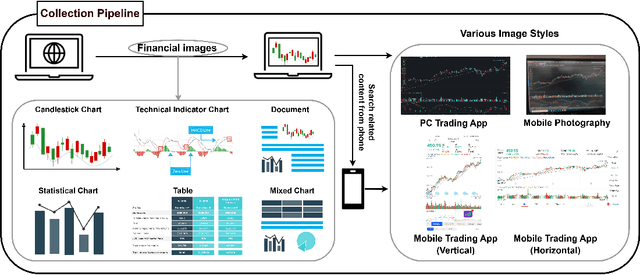
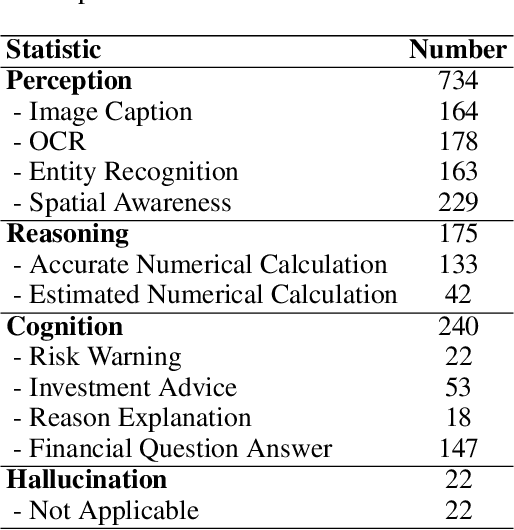
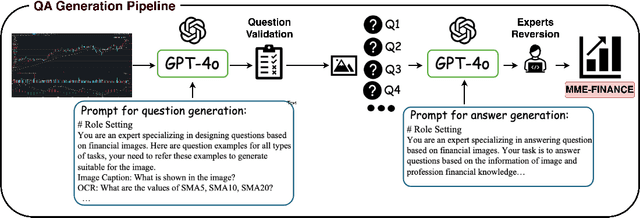
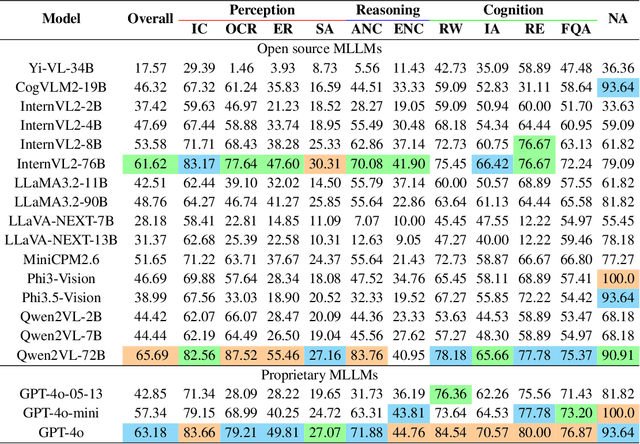
Abstract:In recent years, multimodal benchmarks for general domains have guided the rapid development of multimodal models on general tasks. However, the financial field has its peculiarities. It features unique graphical images (e.g., candlestick charts, technical indicator charts) and possesses a wealth of specialized financial knowledge (e.g., futures, turnover rate). Therefore, benchmarks from general fields often fail to measure the performance of multimodal models in the financial domain, and thus cannot effectively guide the rapid development of large financial models. To promote the development of large financial multimodal models, we propose MME-Finance, an bilingual open-ended and practical usage-oriented Visual Question Answering (VQA) benchmark. The characteristics of our benchmark are finance and expertise, which include constructing charts that reflect the actual usage needs of users (e.g., computer screenshots and mobile photography), creating questions according to the preferences in financial domain inquiries, and annotating questions by experts with 10+ years of experience in the financial industry. Additionally, we have developed a custom-designed financial evaluation system in which visual information is first introduced in the multi-modal evaluation process. Extensive experimental evaluations of 19 mainstream MLLMs are conducted to test their perception, reasoning, and cognition capabilities. The results indicate that models performing well on general benchmarks cannot do well on MME-Finance; for instance, the top-performing open-source and closed-source models obtain 65.69 (Qwen2VL-72B) and 63.18 (GPT-4o), respectively. Their performance is particularly poor in categories most relevant to finance, such as candlestick charts and technical indicator charts. In addition, we propose a Chinese version, which helps compare performance of MLLMs under a Chinese context.
TimeCNN: Refining Cross-Variable Interaction on Time Point for Time Series Forecasting
Oct 07, 2024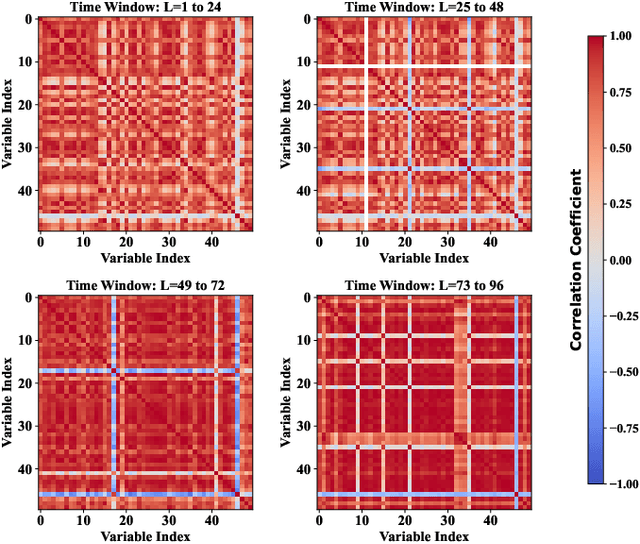
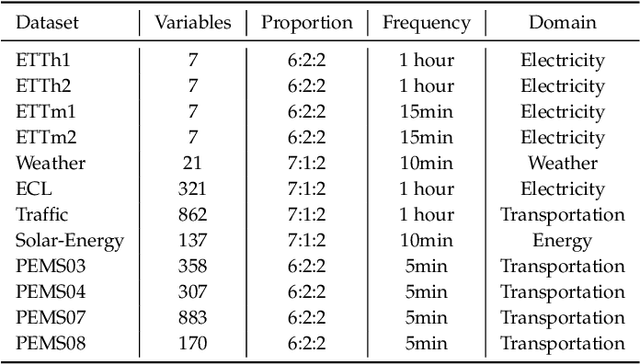
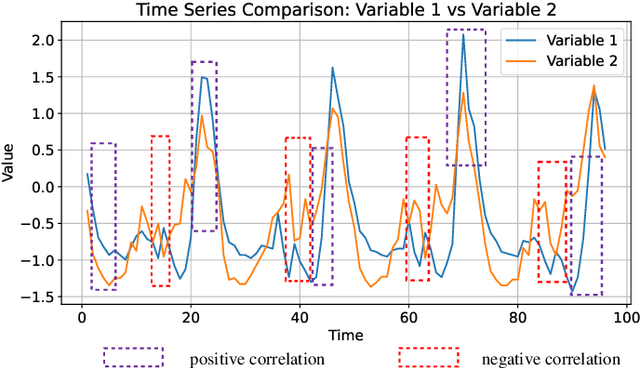
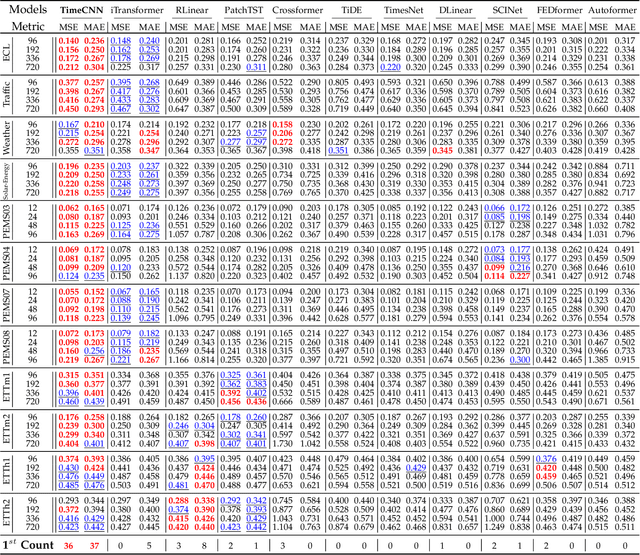
Abstract:Time series forecasting is extensively applied across diverse domains. Transformer-based models demonstrate significant potential in modeling cross-time and cross-variable interaction. However, we notice that the cross-variable correlation of multivariate time series demonstrates multifaceted (positive and negative correlations) and dynamic progression over time, which is not well captured by existing Transformer-based models. To address this issue, we propose a TimeCNN model to refine cross-variable interactions to enhance time series forecasting. Its key innovation is timepoint-independent, where each time point has an independent convolution kernel, allowing each time point to have its independent model to capture relationships among variables. This approach effectively handles both positive and negative correlations and adapts to the evolving nature of variable relationships over time. Extensive experiments conducted on 12 real-world datasets demonstrate that TimeCNN consistently outperforms state-of-the-art models. Notably, our model achieves significant reductions in computational requirements (approximately 60.46%) and parameter count (about 57.50%), while delivering inference speeds 3 to 4 times faster than the benchmark iTransformer model
IDGen: Item Discrimination Induced Prompt Generation for LLM Evaluation
Sep 27, 2024



Abstract:As Large Language Models (LLMs) grow increasingly adept at managing complex tasks, the evaluation set must keep pace with these advancements to ensure it remains sufficiently discriminative. Item Discrimination (ID) theory, which is widely used in educational assessment, measures the ability of individual test items to differentiate between high and low performers. Inspired by this theory, we propose an ID-induced prompt synthesis framework for evaluating LLMs to ensure the evaluation set can continually update and refine according to model abilities. Our data synthesis framework prioritizes both breadth and specificity. It can generate prompts that comprehensively evaluate the capabilities of LLMs while revealing meaningful performance differences between models, allowing for effective discrimination of their relative strengths and weaknesses across various tasks and domains. To produce high-quality data, we incorporate a self-correct mechanism into our generalization framework, and develop two models to predict prompt discrimination and difficulty score to facilitate our data synthesis framework, contributing valuable tools to evaluation data synthesis research. We apply our generated data to evaluate five SOTA models. Our data achieves an average score of 51.92, accompanied by a variance of 10.06. By contrast, previous works (i.e., SELF-INSTRUCT and WizardLM) obtain an average score exceeding 67, with a variance below 3.2. The results demonstrate that the data generated by our framework is more challenging and discriminative compared to previous works. We will release a dataset of over 3,000 carefully crafted prompts to facilitate evaluation research of LLMs.
Prompt Customization for Continual Learning
Apr 28, 2024



Abstract:Contemporary continual learning approaches typically select prompts from a pool, which function as supplementary inputs to a pre-trained model. However, this strategy is hindered by the inherent noise of its selection approach when handling increasing tasks. In response to these challenges, we reformulate the prompting approach for continual learning and propose the prompt customization (PC) method. PC mainly comprises a prompt generation module (PGM) and a prompt modulation module (PMM). In contrast to conventional methods that employ hard prompt selection, PGM assigns different coefficients to prompts from a fixed-sized pool of prompts and generates tailored prompts. Moreover, PMM further modulates the prompts by adaptively assigning weights according to the correlations between input data and corresponding prompts. We evaluate our method on four benchmark datasets for three diverse settings, including the class, domain, and task-agnostic incremental learning tasks. Experimental results demonstrate consistent improvement (by up to 16.2\%), yielded by the proposed method, over the state-of-the-art (SOTA) techniques.
Self-playing Adversarial Language Game Enhances LLM Reasoning
Apr 16, 2024Abstract:We explore the self-play training procedure of large language models (LLMs) in a two-player adversarial language game called Adversarial Taboo. In this game, an attacker and a defender communicate with respect to a target word only visible to the attacker. The attacker aims to induce the defender to utter the target word unconsciously, while the defender tries to infer the target word from the attacker's utterances. To win the game, both players should have sufficient knowledge about the target word and high-level reasoning ability to infer and express in this information-reserved conversation. Hence, we are curious about whether LLMs' reasoning ability can be further enhanced by Self-Play in this Adversarial language Game (SPAG). With this goal, we let LLMs act as the attacker and play with a copy of itself as the defender on an extensive range of target words. Through reinforcement learning on the game outcomes, we observe that the LLMs' performance uniformly improves on a broad range of reasoning benchmarks. Furthermore, iteratively adopting this self-play process can continuously promote LLM's reasoning ability. The code is at https://github.com/Linear95/SPAG.
Prior-agnostic Multi-scale Contrastive Text-Audio Pre-training for Parallelized TTS Frontend Modeling
Apr 14, 2024Abstract:Over the past decade, a series of unflagging efforts have been dedicated to developing highly expressive and controllable text-to-speech (TTS) systems. In general, the holistic TTS comprises two interconnected components: the frontend module and the backend module. The frontend excels in capturing linguistic representations from the raw text input, while the backend module converts linguistic cues to speech. The research community has shown growing interest in the study of the frontend component, recognizing its pivotal role in text-to-speech systems, including Text Normalization (TN), Prosody Boundary Prediction (PBP), and Polyphone Disambiguation (PD). Nonetheless, the limitations posed by insufficient annotated textual data and the reliance on homogeneous text signals significantly undermine the effectiveness of its supervised learning. To evade this obstacle, a novel two-stage TTS frontend prediction pipeline, named TAP-FM, is proposed in this paper. Specifically, during the first learning phase, we present a Multi-scale Contrastive Text-audio Pre-training protocol (MC-TAP), which hammers at acquiring richer insights via multi-granularity contrastive pre-training in an unsupervised manner. Instead of mining homogeneous features in prior pre-training approaches, our framework demonstrates the ability to delve deep into both global and local text-audio semantic and acoustic representations. Furthermore, a parallelized TTS frontend model is delicately devised to execute TN, PD, and PBP prediction tasks, respectively in the second stage. Finally, extensive experiments illustrate the superiority of our proposed method, achieving state-of-the-art performance.
Look Before You Leap: Towards Decision-Aware and Generalizable Tool-Usage for Large Language Models
Feb 28, 2024



Abstract:Tool-augmented large language models (LLMs) are attracting widespread attention when accessing up-to-date knowledge and alleviating hallucination issues. Nowadays, advanced closed-source LLMs (e.g., ChatGPT) have demonstrated surprising tool-usage capabilities through prompting and in-context learning techniques. To empower the capabilities of open-source LLMs (e.g., LLaMA) in manipulating tools, current efforts focus on either template-driven or token-triggered tool-usage. However, the former hampers LLMs' flexibility to address diverse user's queries due to constrained tool interactions, while the latter limits the generalizability when engaging with new tools, since tool-usage learning is based on task- and tool-specific datasets. To alleviate these concerns, in this paper, we propose a decision-aware and generalizable tool-usage framework (DEER). Specifically, we first construct the tool-usage samples with multiple decision branches via an automatic generation pipeline, thereby inspiring the decision-making awareness of LLMs under diverse scenarios. Meanwhile, we propose a novel tool sampling strategy to enhance the generalizability of LLMs over unseen tools. Extensive experiments demonstrate that our proposed DEER is effective and significantly outperforms baselines across various datasets.
Enhancing Zero-shot Counting via Language-guided Exemplar Learning
Feb 08, 2024Abstract:Recently, Class-Agnostic Counting (CAC) problem has garnered increasing attention owing to its intriguing generality and superior efficiency compared to Category-Specific Counting (CSC). This paper proposes a novel ExpressCount to enhance zero-shot object counting by delving deeply into language-guided exemplar learning. Specifically, the ExpressCount is comprised of an innovative Language-oriented Exemplar Perceptron and a downstream visual Zero-shot Counting pipeline. Thereinto, the perceptron hammers at exploiting accurate exemplar cues from collaborative language-vision signals by inheriting rich semantic priors from the prevailing pre-trained Large Language Models (LLMs), whereas the counting pipeline excels in mining fine-grained features through dual-branch and cross-attention schemes, contributing to the high-quality similarity learning. Apart from building a bridge between the LLM in vogue and the visual counting tasks, expression-guided exemplar estimation significantly advances zero-shot learning capabilities for counting instances with arbitrary classes. Moreover, devising a FSC-147-Express with annotations of meticulous linguistic expressions pioneers a new venue for developing and validating language-based counting models. Extensive experiments demonstrate the state-of-the-art performance of our ExpressCount, even showcasing the accuracy on par with partial CSC models.
Embracing Language Inclusivity and Diversity in CLIP through Continual Language Learning
Jan 30, 2024Abstract:While vision-language pre-trained models (VL-PTMs) have advanced multimodal research in recent years, their mastery in a few languages like English restricts their applicability in broader communities. To this end, there is an increasing interest in developing multilingual VL models via a joint-learning setup, which, however, could be unrealistic due to expensive costs and data availability. In this work, we propose to extend VL-PTMs' language capacity by continual language learning (CLL), where a model needs to update its linguistic knowledge incrementally without suffering from catastrophic forgetting (CF). We begin our study by introducing a model dubbed CLL-CLIP, which builds upon CLIP, a prevailing VL-PTM that has acquired image-English text alignment. Specifically, CLL-CLIP contains an expandable token embedding layer to handle linguistic differences. It solely trains token embeddings to improve memory stability and is optimized under cross-modal and cross-lingual objectives to learn the alignment between images and multilingual texts. To alleviate CF raised by covariate shift and lexical overlap, we further propose a novel approach that ensures the identical distribution of all token embeddings during initialization and regularizes token embedding learning during training. We construct a CLL benchmark covering 36 languages based on MSCOCO and XM3600 datasets and then evaluate multilingual image-text retrieval performance. Extensive experiments verify the effectiveness of CLL-CLIP and show that our approach can boost CLL-CLIP, e.g., by 6.7% in text-to-image average Recall@1 on XM3600, and improve various state-of-the-art methods consistently. Our code and data are available at \url{https://github.com/yangbang18/CLFM}.
WebVoyager: Building an End-to-End Web Agent with Large Multimodal Models
Jan 28, 2024Abstract:The advancement of large language models (LLMs) leads to a new era marked by the development of autonomous applications in the real world, which drives innovation in the creation of advanced web-based agents. Existing web agents typically only handle one input modality and are evaluated only in simplified web simulators or static web snapshots, greatly limiting their applicability in real-world scenarios. To bridge this gap, we introduce WebVoyager, an innovative Large Multimodal Model (LMM) powered web agent that can complete user instructions end-to-end by interacting with real-world websites. Moreover, we propose a new evaluation protocol for web agents to address the challenges of automatic evaluation of open-ended web agent tasks, leveraging the robust multimodal comprehension capabilities of GPT-4V. We create a new benchmark by gathering real-world tasks from 15 widely used websites to evaluate our agents. We show that WebVoyager achieves a 55.7% task success rate, significantly surpassing the performance of both GPT-4 (All Tools) and the WebVoyager (text-only) setups, underscoring the exceptional capability of WebVoyager in practical applications. We found that our proposed automatic evaluation achieves 85.3% agreement with human judgment, paving the way for further development of web agents in a real-world setting.
 Add to Chrome
Add to Chrome Add to Firefox
Add to Firefox Add to Edge
Add to Edge